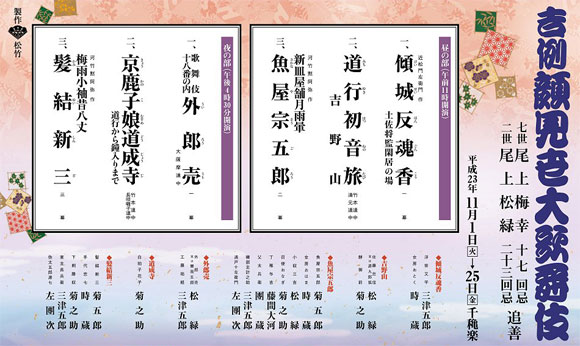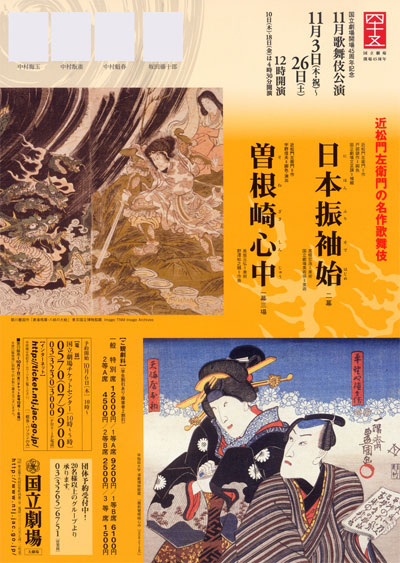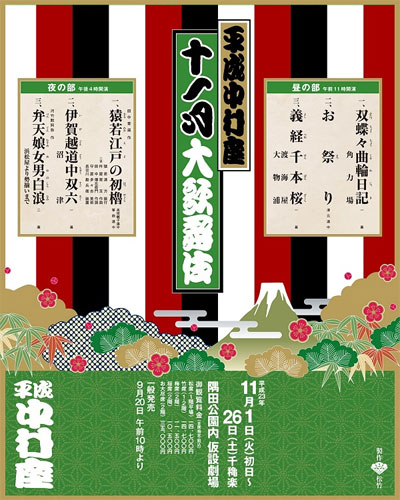| NOVEMBER 2011 |
| Shinbashi Enbuj˘ (T˘ky˘) |
| Dates | 1 ~ 25 November 2011 (Kichirei Kaomise ďkabuki) Annual Festive Face-Showing Grand Kabuki |
| MatinÚe |
Keisei Hangonk˘ (Domo Mata) |
| Evening | |
| Casting |
Onoe Kikugor˘, Band˘ Mitsugor˘, Nakamura Tokiz˘, Onoe Kikunosuke, Ichikawa Danz˘, Ichikawa Sadanji, Band˘ Hikosabur˘, Onoe Sh˘roku, Sawamura Tanosuke, Kawarasaki Gonjűr˘, Kataoka Kamez˘, Band˘ Shűch˘, Ichimura Manjir˘, Band˘ Kamesabur˘, Band˘ Kametoshi, Onoe Matsuya, Onoe Ukon, Nakamura Baishi, Band˘ Kokichi, Nakamura Mantar˘, Ichikawa Otora, Fujima Taiga |
| Comments |
This kaomise programs at the Shinbashi Enbuj˘ are staged to commemorate the 22th anniversary (23rd memorial service) and the 16th anniversary (17th memorial service) of the deaths of late Onoe Sh˘roku II and Onoe Baik˘ VII.
|
 |
|
|||
| Dates | 2 ~ 26 June 2011 (Kinshű Hakataza ďkabuki) Autumn Brocade Hakataza Grand Kabuki |
||
| MatinÚe |
Yowa Nasake Ukina no Yokogushi (Kirare Yosa)
|
||
| Evening |
Ashiya D˘man ďuchi Kagami (Kuzu-no-Ha) Y˘kihi |
||
| Casting |
Ichikawa Danjűr˘, Ichikawa Ebiz˘, Nakamura Shibajaku, Nakamura Fukusuke, Nakamura Karoku, Ichikawa Ukon, Ichikawa En'ya, Ichikawa Unosuke, Ichimura Kakitsu, Ichikawa Monnosuke, Kataoka Ichiz˘, Ichikawa Juen, Ichikawa Emisabur˘, Ichikawa Shun'en, ďtani Keiz˘, Nakamura Shinobu, Nakamura Yonekichi |
||
| Comments |
|
||
| National Theatre (T˘ky˘) |
| Dates | 3 ~ 26 November 2011 |
| Program | |
| Casting |
Sakata T˘jűr˘, Nakamura Baigyoku, Nakamura Kanjaku, Nakamura Kaishun, Nakamura T˘z˘, Band˘ Takesabur˘, Nakamura Kikaku, Nakamura Matsue, Nakamura Utae, Matsumoto Kingo, Nakamura Umemaru |
| Comments |
To commemorate the forty-fifth anniversary of the founding of the National Theatre, typical author of Kabuki is taken up every month. This month: Chikamatsu Monzaemon. The National Theatre produces two masterpieces, the jidaimono "Nihon Furisode Hajime" and the sewamono "Sonezaki Shinjű".
|
 |
| Heisei Nakamuraza (T˘ky˘) | |
| Dates | 1 ~ 26 November 2011 (Jűichigatsu ďkabuki) November Grand Kabuki |
| MatinÚe |
Futatsu Ch˘ch˘ Kuruwa Nikki (Sum˘ba)
|
| Evening |
Saruwaka Edo no Hatsuyagura Igagoe D˘chű Sugoroku (Numazu) Benten Musume Meo no Shiranami
|
| Casting |
Nakamura Kanzabur˘, Kataoka Nizaemon, Nakamura Hashinosuke, Kataoka Takatar˘, Band˘ Yajűr˘, Nakamura Kantar˘, Nakamura Shichinosuke |
| Comments |
The Heisei Nakamuraza is back in T˘ky˘ in the popular district of Asakusa. This time, it is a 7-month project (performances up to May 2012!) for this temporary theater built within the Sumida Park.
|
 |
| Sh˘chiku Hanagata Kabuki Tour | |
| Dates | 1 ~ 25 November 2011 (Sh˘chiku Hanagata Kabuki) Sh˘chiku Young Actors Kabuki |
| Program | |
| Casting |
Kataoka Hidetar˘, Nakamura Shid˘, Ichikawa Emiya, Sawamura S˘nosuke, Ichikawa Omez˘, Sawamura Yoshijir˘ |
| Comments |
A special Autumn tour sponsored by the Sh˘chiku:
|
|
|||
| Dates | 1 ~ 14 November 2011 Band˘ Tamasabur˘ Special Dance Performances |
||
| Program |
Shunkashűt˘ |
||
| Casting | |||
| Comments |
A special Buy˘ program starring the amazing onnagata Band˘ Tamasabur˘ in Yamaga at the Yachiyoza, a traditional wooden-built theater, which celebrates the 100th anniversary of its opening. "Shunkashűt˘" is a newly-created dance about Japan four seasons; shun is spring, ka is summer, shű is autumn and t˘ is winter. |
||
| Eirakukan (Toyooka) |  |
| Dates | 4 ~ 9 November 2011 (Eirakukan ďkabuki) Eirakukan Grand Kabuki |
| Program | |
| Casting |
Kataoka Ainosuke, Nakamura Kinnosuke, Kamimura Kichiya, Nakamura Kazutar˘, Nakamura Hayato, Kataoka T˘jur˘ |
| Comments |
This is the 4th Kabuki program at the Eirakukan, a renovated traditional theater built in the city of Toyooka (prefecture of Hy˘go).
|
| ďtsuka Museum of Art (Naruto) |
| Dates | 12 ~ 14 November 2011 (Sistine Kabuki) |
| Program |
Ishikawa Goemon |
| Casting | |
| Comments |
Third edition of the Sistine Kabuki, a Kabuki program within the Sistine Hall of the ďtsuka Museum of Art, which is located in the city of Naruto (Tokushima prefecture). Inside this museum, there are more than 1,000 replicas of priceless masterpieces of Western art, from ancient murals to modern paintings, which are reproduced in ceramic to their original size. The Sistine Hall is of course a "reproduction" of the Vatican Sistine Chapel. |
| Zenshinza Tour | |
| Dates | 21 ~ 25 November 2011 |
| Program |
Mizusawa no Ichiya |
| Casting |
Arashi Keishi, Kawarasaki Kunitar˘, Arashi Yoshisabur˘, Yamazaki Tatsusabur˘, Yamazaki Ryűnosuke, Ikushima Kigor˘, Matsunami Kihachir˘ |
| Comments |
The Zenshinza troupe is on tour all over Japan. "Mizusawa no Ichiya" is not a Kabuki drama. Only "Kenuki": Source: Earphone Guide website |
|
|
| Contact | Main | Top | Updates | Actors | Plays | Playwrights | Programs | Links | FAQ | Glossary | Chronology | Illustrations | Prints | Characters | Derivatives | Theaters | Coming soon | News |
